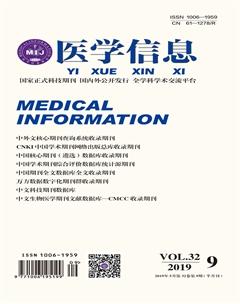肾功能亢进及对药物代谢的影响
刘代华 罗宜辉
摘要:肾功能亢进(ARC)在临床广泛存在,但未引起重视。ARC可导致经肾排泄的药物代谢增快,导致治疗失败,对于危重症患者的治疗尤为重要。目前对于ARC的药物代谢研究较少,本文主要就ARC的流行病学、发病机理,及近年来报道比较多的万古霉素、β-内酰胺类抗生素、氨基糖胺类和左乙拉西坦做一综述。
关键词:肾功能亢进;万古霉素;β-内酰胺类抗生素;氨基糖苷类;左乙拉西坦;药物代谢
中图分类号:R969.1 文献标识码:A DOI:10.3969/j.issn.1006-1959.2019.09.016
文章编号:1006-1959(2019)09-0048-04
Abstract:Adrenal hyperfunction (ARC) is widespread in the clinic but has not received much attention. ARC can increase the metabolism of drugs excreted by the kidneys, leading to treatment failure, which is especially important for the treatment of critically ill patients. At present, there are few studies on drug metabolism of ARC. This article mainly focuses on the epidemiology, pathogenesis of ARC, and more recently reported vancomycin, β-lactam antibiotics, aminoglycosides and levetiracetam. Do a review.
Key words:Hyperkalemia;Vancomycin;β-lactam antibiotics;Aminoglycosides;Levetiracetam;Drug metabolism
肾功能亢进(augmented renal clearance,ARC)在重症患者中普遍存在,一般指肌酐清除率大于130 ml/(min·1.73m2),以8~24 h尿肌酐排出较以血肌酐估算更能准确预测ARC。ARC的高危因素包括年龄<50岁、男性、近期有创伤病史、较低的危重病严重程度评分。ARC使经肾排泄的药物排出增加,对存在ARC的患者给予正常剂量的药物往往导致治疗失败,临床需引起足够的重视。
1 ARC的定义、流行病学及病理生理
ARC指肾脏高滤过状态,由于肾脏清除能力增加,可能导致经肾排的药物清除增加从而导致治疗的失败,该现象在ICU患者中比較常见。临床常用肌酐清除率(creatinine clearance,CrCl)来评估患者是否存在ARC,但对于折点仍存在争议,目前普遍将患者CrCl>130 ml/(min·1.73m2)认为存在ARC[1-3],但也有研究将折点定为CrCl>120 ml/(min·1.73m2)[4,5]或CrCl>160 ml/(min·1.73m2)[6]。
ARC虽然在临床中普遍存在,但在临床工作中经常被忽略,报道的发病率为14%~80%[7]。目前对ARC的机制认识仍有限,认为是机体对损伤的一种反应,体温、脑自身调节、全身高动力状态可能与ARC有关[8]。研究发现急性炎症可导致体温升高,从而血管通透性和肾血流量增加,导致ARC[9];正常体温患者(中位体温=37.2℃)较低体温(中位体温=34℃)患者对万古霉素的清除率高[10]。脑损伤也会导致ARC,通过对创伤性脑损伤患者的研究发现,脑创伤后的自动调节能力减低及心钠素(atrial natriuretic peptide,ANP)升高都与ARC有关[6]。系统炎性反应导致的外周血管阻力减少、心输出量增加,液体治疗,血管活性药物及强心药物的使用,导致全身的高动力状态,都可导致ARC[11]。虽然有很多关于ARC的研究,但其确切的机制仍不清楚。
2 ARC的危险因素和评估方法
ARC更易发生于年轻(<50岁)、男性、近期有创伤史、较低的疾病评分(如SOFA、SAPS II、 APACHEⅡ评分等)的患者[12,13]。另外Hirai K等研究发现中性粒细胞减少伴发热是儿童癌症患者发生ARC的独立危险因素[6]。
为更好的预测ARC的发生,Baptista JP等[14]通过对ICU患者的研究,采用尿肌酐>45 mg/ml、年龄<65周岁可很好的预测ARC的发生(敏感度60%,特异度88%);如增加BUN<7 mmol/L,可将特异度提高至95%。有研究采用年龄<50周岁、近期有创伤史、SOFA评分≤4分的ARC评分,其敏感度和特异度分别为100%和71%。Barletta JF等[15]改良了ARC评分,用于创伤重症患者的肾功能亢进评分(ARC in trauma intensive care,ARCTIC)。ARCTIC评分项包括血清肌酐、性别、年龄和SOFA评分,其精确度和敏感度分别为84%和68%。用ARC或ARCTIC评分,能尽早发现患者是否存在ARC,可以更好的选择抗生素的种类或剂量,提高疗效。
尽管危险因素和预测模型能筛查ARC,但真正识别患者是否发生ARC需要准确计算患者的肾小球滤过率(glomerular filtration rate,GFR)。菊粉清除被认为是测量GFR的金标准,而临床常用的根据血清肌酐估算GFR的公式如CrCl、MDRD、简化MDRD、CKD-EPI等,因为血清肌酐会受患者身体影响,如肌肉含量、是否截肢、饮食等影响,对特定人群可能存在过高或过低估算。研究显示,所有的估算公式都过低估计ARC患者的肾功能。相比其他估算公式,CG公式能更好的预测ARC[16,17]。由于菊粉检测肾功能需要注入外源性物质,一般仅用于试验,目前临床常通过测量8~24 h尿中肌酐评估肾功能[18]。
3 ARC患者药代动力学改变
对ICU患者而言,因ARC导致的药动学的改变可能会直接影响治疗效果,特别是对经肾排泄与肌酐清除有直接联系的药物,如氨基糖苷类抗生素、万古霉素和左乙拉西坦。增加药物的清除会导致药物半衰期缩短(t1/2)、降低最大药物浓度(Cmax)和药物曲线下面积(AUC),特别是对于时间依赖性和浓度依赖性抗生素来说,药动学的改变将导致治疗失败。而在药品说明书和各类指南中均未提及需对存在ARC患者调整药物剂量。对英格兰ICU医生的调查显示,仅15%的医生会对存在ARC的患者调整β-内酰胺类和万古霉素剂量[19]。所以我们需要加强对存在ARC患者药物剂量进行调整。
3.1万古霉素 万古霉素是糖肽类抗生素,用于治疗革兰氏阳性菌导致的严重感染。它是一个亲水性的药物,80%~90%以原型经肾排泄,药物排泄量与肾功能密切相关。通过对药动学和药代学的研究,建立了以谷浓度替代AUC∶MIC的监测方式,能很好的预测临床疗效[20]。但越来越多的证据表明,在存在ARC的患者中常规剂量的万古霉素往往不能达到有效治疗浓度。Campassi ML等[4]研究显示,存在ARC的患者即使起始剂量给予较高的万古霉素,用药后3 d内没有患者谷浓度达到15~25 mg/L。目前针对存在ARC患者万古霉素血药浓度与临床疗效的研究很少。但研究表明在给药后48 h内万古霉素谷浓度不能达到15~25 mg/L,住院患者死亡率较达标患者明显升高(OR=2.1,P=0.003)[21]。
对存在ARC的患者,各种万古霉素的给药方案被建议或测试。Vermis K等[5]通过监测万古霉素谷浓度,对患者用药后5 d内的给药剂量进行调整。对存在ARC和没有ARC的患者,分别需给予42 mg/(kg·d)和33 mg/(kg·d)的万古霉素才能达到目标谷浓度。对CrCl>130 ml/min的患者,作者建议万古霉素起始剂量为25 mg/kg、日剂量为40 mg/kg。同样,Minkute R等[22]研究显示万古霉素需要44 kg/(kg·d)才能达到目标谷浓度。另外有研究建议采用8 h测得的肌酐清除率或列线图调整给药剂量,在ARC患者中均能获得较好的谷浓度达标率。
3.2 β-内酰胺类抗生素 β-内酰胺类抗生素主要经肾排泄,存在ARC对药物代谢影响较大。与万古霉素和氨基糖苷类抗生素不同,临床医生常根据指南推荐剂量使用,一般不进行治疗药物浓度监测。但对存在ARC的患者,目前没有相关的指南推荐剂量,按常规剂量给药,常导致治疗失败。
碳青霉烯类抗生素是一类治疗多重耐药菌的广谱β-内酰胺类抗生素,其抗菌活性具有时间依赖性,T>MIC药效学模型能较好地反映其抗菌活性[23]。但多数研究结果显示,存在ARC的患者按常规剂量给药难达到有效治疗浓度。Binder L等[24]报道对估算GFR>60 ml/min的ICU患者,给与标准剂量的美罗培南(500~1000 mg/8~12 h),随着清除率增加,导致较低的AUC。Drust A等[25]报道CrCl>120 ml/min的ICU患者中,2/3的患者需要比目前推荐更高的剂量(8 g/d)才能达到有效的治疗浓度。另外,延长输注时间也可以增加T>MIC、提高治疗成功率。Carlier M等采用2个不同的给药方案(1 g,q8h,输注30 min vs 3 h),发现延长输注时间能提高94%的不存在ARC患者的T>MIC的达标率,而仅61%的存在ARC的患者有改善[26]。多利培南在存在ARC患者的研究也得到类似的结论,均提示对存在ARC的患者建议提高给药剂量[27]。
对哌拉西林/他唑巴坦在ICU存在ARC患者的研究发现,常规剂量给药或延迟输注时间也不能很好的达到有效治疗浓度,而需增加给药剂量。有研究利用蒙特卡洛模拟计算对存在ARC的患者给药剂量需高于FDA的推荐最高剂量,需达到(36 g/d),但该研究并未评估其给药方案的有效性,仍需进一步验证[28,29]。
对ICU存在ARC儿童使用阿莫西林克拉维酸钾的研究发现,相比25 mg/kg或35 mg/kg q6h的给药方案,25 mg/kg q4h的给药方案能更好的使药物浓度达标,取得更好的临床疗效,输注时间延长至1 h比增大给药剂量更可取[30]。其他β-内酰胺类抗菌药物在ARC患者中的代谢可能同样存在代谢增快,但研究较少,还需进一步研究。
3.3其他药物 氨基糖苷类药物主要经肾排泄,通过血清浓度测定预测治疗效果。Goboova M等[31]对存在ARC的患者使用庆大霉素的回顾性研究发现,使用常规剂量,93%的患者峰浓度未达有效治疗浓度,需要增加给药剂量。该研究提示对存在ARC的患者需调整给药剂量。
氟喹诺酮类也是经肾排泄的药物。目前推荐剂量对于正常或肾功能受損的患者治疗效果的可预测性,不需要进行治疗药物浓度监测(TDM)。但TDM对存在ARC的患者需要提高给药剂量时仍有必要。比如,CrCl>130 ml/min的患者感染肺炎链球菌、铜绿假单胞菌和金黄色葡萄球菌,利用蒙特卡洛模拟推荐的治疗剂量为1 g/24 h,而常规的剂量为0.5~0.75 g/24 h[32]。
除了抗生素,其他藥物在ARC患者中的药物代谢也有研究,如左乙拉西坦和依诺肝素。左乙拉西坦是一种广谱抗癫痫药,主要经肾排泄,呈线性代谢。存在ARC的患者左乙拉西坦代谢增快,建议ARC高危患者给与较高剂量(1 g 静滴 q8h)[33]。依诺肝素经肝代谢,10%以原形经肾代谢,给药总量的40%经肾排泄。但有报道ARC会影响依诺肝素的疗效,建议加强对抗Xa活性的监测[34]。
4总结
ARC在临床广泛存在,可发生于患者住院的任何时期,持续1 d或数周不等。临床对该现象的认识普遍不足,特别是对于危重症患者,在疾病早期用药不足,从而导致治疗失败。目前推荐的诊断方法是测量患者8~24 h尿肌酐,建议每天监测。尽早识别高危患者是否存在ARC,及时根据患者肾功能调整药物治疗方案,经肾排泄的药物尽量选择高剂量给药,或者选择不经肾排的药物,提高药物治疗疗效。
参考文献:
[1]Udy AA,Putt MT,Boots RJ,et al.ARC-Augmented renal clearance[J].Curr Pharm Biotechnol,2011,12(12):2020-2029.
[2]Udy AA,Roberts JA,Boots RJ,et al.Augmented renal clearance:Implications forantibacterial dosing inthecritically ill[J].Cli Pharmacokinet,2010,49(1):1-16.
[3]Udy AA,Putt MT,Shanmugathasan S,et al.Augmented renal clearance in the intensive care unit: An illustrative case series[J].Int J Antimicrob Agents,2010,35(6):606-608.
[4]Campassi ML,Gonzalez MC,Masevicius FD,et al.Augmented renal clearance in critically ill patients: Incidence, associated factors and effects on vancomycin treatment[J].Rev Bras TerIntensiv,2014,26(1):13-20.
[5]Vermis K,Steel E,Vandenbroucke J.Prevalence of augmented renal clearance in haematological patientsand the impact on vancomycin dosing[J]. Journal of Oncology Pharmacy Practice,2014(20):7.
[6]Hirai K,Ihara S,Kinae A,et al.Augmented renal clearance inpediatric patients with febril eneutropenia associated with vancomycin clearance[J].Ther Drug Monit,2016,38(3):393-397.
[7]Mahmoud SH,Shen C.Augmented renal clearance in critical illness:an important consideration in drug dosing[J].Pharmaceutics,2017,9(3):E36.
[8]Huttner A,Von Dach E,Renzoni A,et al.Augmented renal clearance,low beta-lactam concentrations and clinical outcomes in the critically ill: An observational prospective cohort study[J].Int J Antimicrob Agents,2015,45(4):385-392.
[9]Georges B,Conil JM,Ruiz S,et al.Ceftazidime dosage regimen in intensive care unit patients: from a population pharmacokinetic approach to clinical practice via Monte Carlo simulations[J]. Br J Clin Pharmacol,2012,73(4):588-596.
[10]Morbitzer KA,Jordan JD,Rhoney DH.Vancomycin pharmacokinetic parameters in patients with acute brain injury undergoing controlled normothermia,therapeutic hypothermia,or pentobarbital infusion[J].Neurocrit Care,2015,22(2):258-264.
[11]Sime FB,Udy AA,Roberts JA.Augmented renal clearance in critically ill patients:Etiology, definition and implications for beta-lactam dose optimization[J].Curr Opin Pharmacol,2015(24): 1-6.
[12]Udy AA,Roberts JA,Shorr AF,et al.Augmented renal clearance in septic and traumatized patients with normal plasma creatinine concentrations: Identifying at-risk patients[J].Crit Care,2013,17(1):R35.
[13]Minville V,Asehnoune K,Ruiz S,et al.Increased creatinine clearance in polytrauma patients with normal serum creatinine: A retrospective observational study[J].Crit Care,2011,15(1):R49.
[14]Baptista JP,Silva N,Costa E,et al.Identification of the critically ill patient with augmented renal clearance: Make do with what you have![J].ESICM,2014,40(Suppl 1):S110.
[15]Barletta JF,Mangram AJ,Byrne M,et al.Identifying augmented renal clearance in trauma patients:Validation of the augmented renal clearance in trauma intensive care (arctic) scoring system[J].J Trauma Acute Care Surg,2017,82(4):665-671.
[16]Carlier M,Dumoulin A,Janssen A,et al.Comparison of different equations to assess glomerular filtration in critically ill patients[J].Intensive Care Med,2015,41(3):427-435.
[17]Sunder S,Jayaraman R,Mahapatra HS,et al.Estimation of renal function in the intensive care unit: The covert concepts brought to light[J].J Intensive Care,2014,2(1):31.
[18]Baptista JP,Udy AA,Sousa E,et al.A comparison of estimates of glomerular filtration in critically ill patients with augmented renal clearance[J].Crit Care,2011,15(3):R139.
[19]Dunning J,Roberts J.Assessment of renal function in dosing antibiotics in septic patients: A survey of current practice within critical care units in england[J].Anaesthesia,2015(70):21.
[20]Rybak MJ.The pharmacokinetic and pharmacodynamic properties of vancomycin[J].Clin Infect Dis,2006,42(Suppl 1):S35-S39.
[21]Spadaro S,Berselli A,Fogagnolo A,et al.Evaluation of a protocol for vancomycin administration in critically patients with and without kidney dysfunction[J].BMC Anesthesiol, 2015(15):95.
[22]Minkute R,Briedis V,Steponaviciute R,et al.Augmented renal clearance-An evolving risk factor to consider during the treatment with vancomycin[J].J Clin Pharm Ther,2013,38(6): 462-467.
[23]Mouton JW,Touzw DJ,Horrevorts AM,et al.Comparative pharmacokinetics of the carbapenems: Clinical implications[J].Clin Pharmacokinet,2000,39(3):185-201.
[24]Binder L,Schworer H,Hoppe S,et al.Pharmacokinetics of meropenem in critically ill patients with severe infections[J].Ther Drug Monit,2013,35(1):63-70.
[25]Drust A,Troger U,MartensLobenhoffer J,et al.Therapeutic drug monitoring of meropenem is mandatory for critically ill patients with glomerular hyperfiltration[J].Br J Clin Pharmacol, 2011(72):18.
[26]Carlier M,Carrette S,Roberts JA,et al.Meropenem and piperacillin/tazobactam prescribing in critically ill patients: Does augmented renal clearance affect pharmacokinetic/pharmacodynamic target attainment when extended infusions are used? [J].Crit Care,2013,17(3):R84.
[27]Roberts JA,Lipman J.Optimal doripenem dosing simulations in critically ill nosocomial pneumonia patients with obesity,augmented renal clearance,and decreased bacterial susceptibility[J].Crit Care Med,2013,41(2):489-495.
[28]Huttner A,Von Dach E,Renzoni A,et al.Augmented renal clearance,low beta-lactam concentrations and clinical outcomes in the critically ill: An observational prospective cohort study[J].Int J Antimicrob Agents,2015,45(4):385-392.
[29]Akers KS,Niece KL,Chung KK,et al.Modified augmented renal clearance score predicts rapid piperacillin and tazobactam clearance in critically ill surgery and trauma patients[J].J Trauma Acute Care Surg,2014,77(3 suppl 2):163-170.
[30]De Cock PA,Standing JF,Barker CI,et al.Augmented renal clearance implies a need for increased amoxicillin-clavulanic acid dosing in critically ill children[J].Antimicrob Agents Chemother,2015,59(11):7027-7035.
[31]Goboova M,Kuzelova M,Fazekas T,et al.The impact of therapeutic drug monitoring(TDM) in optimizing dosage regimens of gentamicin in patients with augmented renal clearance[J].Int J Clin Pharm,2016(38):596.
[32]Roberts JA,Cotta MO,Cojutti P,et al.Does critical illness change levofloxacin pharmacokinetics?[J].Antimicrob Agents Chemother,2016,60(3):1459-1463.
[33]May C,Arora S,Parli S,et al.Levetiracetam pharmacokinetics in subarachnoid hemorrhage patients with augmented renal clearance:A monte carlo simulation[J].ACCP,2014(34):e261-e262.
[34]Abdel ENHEM,Abdelhamid MHE,Atteya DAM.Impact of augmented renal clearance on enoxaparin therapy in critically ill patients[J].Egypt J Anaesth,2016,33(1):113-117.
收稿日期:2019-1-12;修回日期:2019-2-1
編辑/肖婷婷
基金项目:广西壮族自治区卫生厅自筹经费科研课题(编号:Z2015124)
作者简介:刘代华(1978.9-),女,湖南沅江人,硕士,副主任药师,药学部副主任,主要从事临床药学研究

